Cotton Processing Market Size
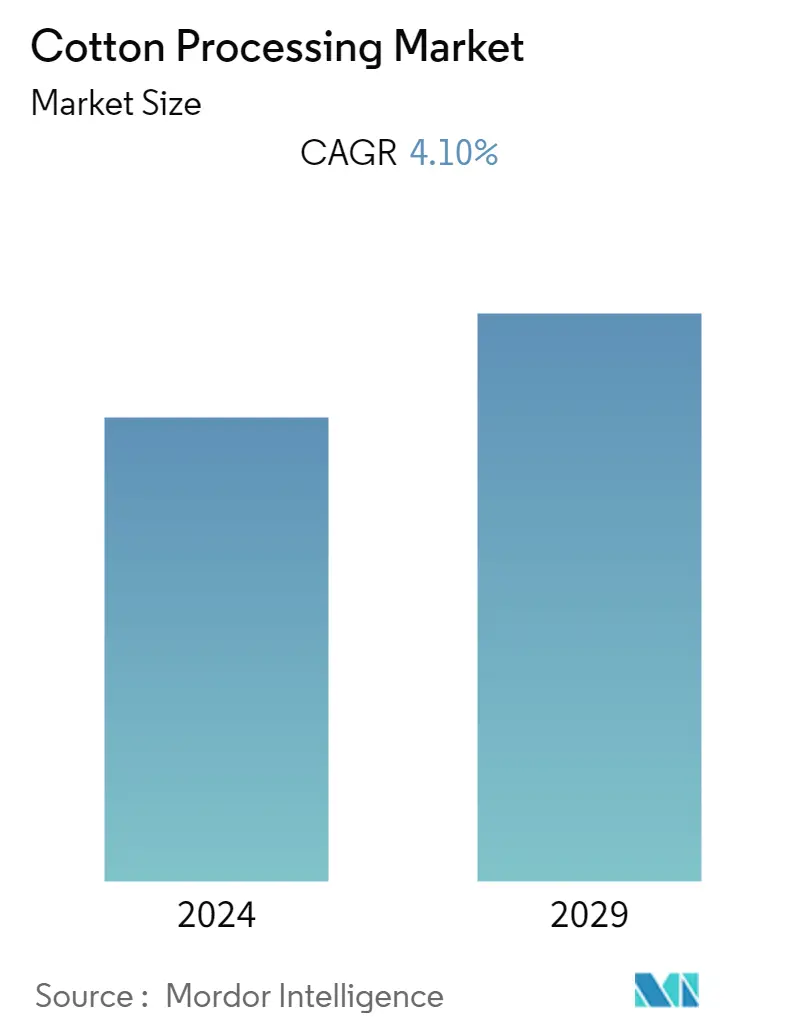
| Study Period | 2019 - 2029 |
| Base Year For Estimation | 2023 |
| CAGR | 4.10 % |
| Fastest Growing Market | Asia Pacific |
| Largest Market | Asia Pacific |
| Market Concentration | High |
Major Players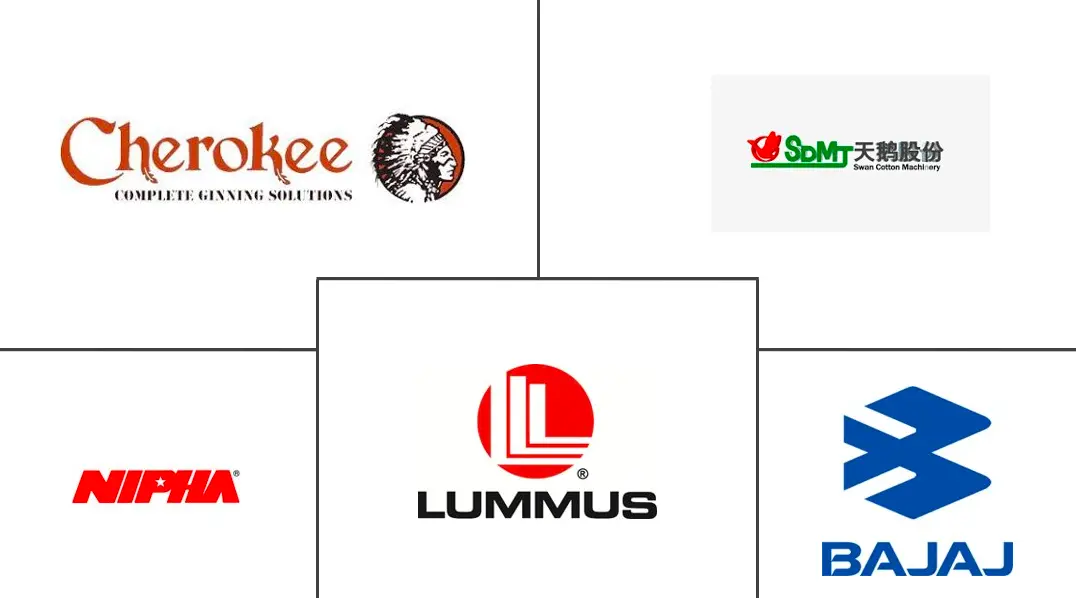
*Disclaimer: Major Players sorted in no particular order |
Cotton Processing Market Analysis
The cotton processing market is projected to register a CAGR of 4.1% during the forecast period,
- The market is likely to be driven by the rising demand for processed cotton, especially from the cotton textile and medical and surgical markets. Raw cotton is used as a key ingredient in textile manufacturing applications, and there are no raw materials to substitute it. Hence, the textile segment has accounted for the largest share of the global cotton processing market.
- In 2022, The Noida Apparel Export Cluster (NAEC) seeked intervention from the government in containing the high cost of cotton yarn and fabrics, saying rising prices are impacting exporters. Indian exporters are losing export orders and facing tough competition in the global export market. Moreover, they are also losing the confidence of the importers and hurting production costs. NAEC president suggested control of cotton exports, removal of 10 percent cotton import duty, and development of a mechanism to regulate the prices of cotton and other raw materials to support the sector. This will raise the growth of the market in the coming years.
- The textile industry's production of fiber through the manufacturing of consumer end products is complicated, with the content of the material often determining the end use. So, The federal government of the United States and the government of India has enacted several laws and regulations governing the sale of textile fibers, materials, and products within the country. According to the Textile Fiber Products Identification Act (TFPIA), specific information about the fiber content of textile products must be included on labels that are prominently attached and securely affixed to the item at the time of sale and delivery to the final consumer. This will develop the bonding between consumers and manufacturers for building the cotton sector and will drive the market to grow during the anticipated years.
- The market is dominated by the Asia Pacific region owing to the high production of cotton in the countries of China, India, and Pakistan. Cotton lint finds application in manufacturing different types of surgical bandages, apparel, and household textiles. The rise in urbanization and change in the lifestyle of consumers has led to an increase in the demand for textiles, which, in turn, is projected to drive the growth of the lint segment further.
Cotton Processing Market Trends
This section covers the major market trends shaping the Cotton Processing Market according to our research experts:
Increasing Textile Production is Driving the Market
Cotton is grown in subtropical and seasonally dry tropical areas in both the northern and southern hemispheres, although most of the world's production takes place north of the equator. The main producing countries are India, China, the United States, Brazil, and Pakistan. Together, these countries account for more than 75% of global production. According to Chemical Fiber Industry Association, global cotton production slightly declined in 2021 with 24.4 million metric ton compared to last year due to the pandemic effect all over the world. India accounting for more than 40% of the global increase. Synthetic fibers are preferably used more than natural fibers because they are more durable and elastic. Synthetic fibers are stronger, softer, and cheaper as compared to natural fibers which are increasing demand and growth of the market in coming years.
In India, Government is promoting organic farming under the schemes viz., Parampragat Krishi Vikas Yojana (PKVY) and Mission Organic Value Chain Development for Northeastern Region (MOVCDNER). Both schemes provide end-to-end support for organic farmers from organic production to certification and marketing including post-harvest management support like processing, packaging, storage, etc. This will make the country grow in the coming years.
Based on consumer interest, organic cotton fiber is used in everything from personal care items like sanitary products, make-up removal pads, cotton puffs, ear swabs), to fabrics, home furnishings like towels, bathrobes, sheets, blankets, bedding, mattresses), children's products, and apparel of all kinds and styles.
In recent years, the production of textiles for both apparel and non-apparel use has increased globally. The textile industry is also a major sector of the global economy, employing hundreds of millions around the world, and thus, it is driven by an increasing global population. Textiles used in automobiles are generally non-apparels broadly used in cars, buses, and trains, and the market is also experiencing good growth owing to the flourishing automobile production and rapid industrialization in emerging nations across the world. The emerging textile markets worldwide rely on the cotton processing market for raw materials, which is driving the market, globally.
The cotton lint segment experiences the highest demand from the textile industry. The rise in urbanization and change in the lifestyle of consumers has led to an increase in the demand for textiles, which, in turn, is projected to drive the growth of the lint segment further. Additionally, the growing awareness about product quality among consumers is projected to reflect positively on the growth of the cotton processing market in the coming years.
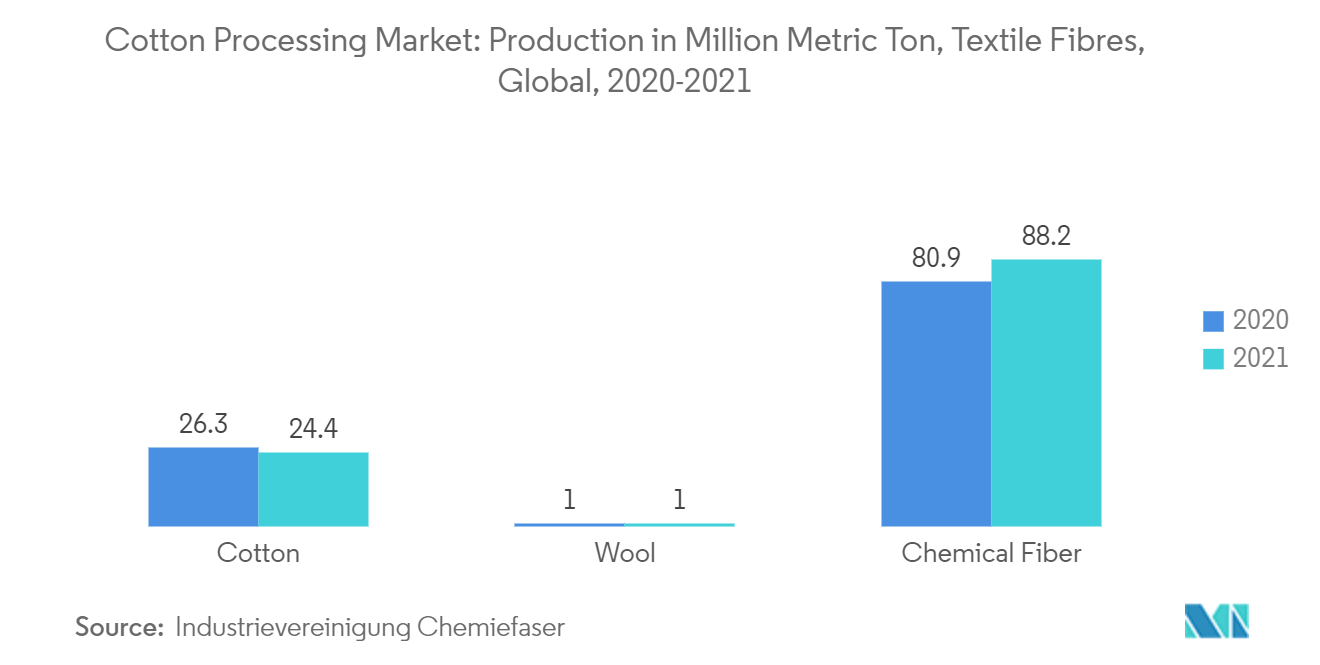
Asia Pacific Leads the Cotton Processing Market
Asia Pacific dominates the current cotton processing market, which is also estimated to lead the market in the forecast period. Some factors influencing this dominance in the market include the rising textile industry, consumer goods, and animal feed in countries, like China, India, Bangladesh, and Pakistan. In addition, approximately two-thirds of cottonseed is used for animal feed, and cottonseed oil is used in a variety of food products, including cookies and chips. The countries in the region have favorable climatic conditions for cotton production.
According to the USDA (United States Department of Agriculture), China and India are the top two users of raw cotton. However, China is the world's leader in processing raw cotton fiber into textiles and apparel because of favorable government policy and the industry has kept consumption below its peak and accounts for one-third of global cotton mill use. India's cotton consumption is second globally, accounting for about 20 percent of the total, while Pakistan contributes another 9 percent; however, both countries' share remains relatively stable. In contrast, upward trends in cotton consumption have occurred in Bangladesh and Vietnam, where companies are shifting their manufacturing to countries with relatively cheap labor, thereby increasing their demand for and consumption of raw cotton fiber.This encourages cotton processors to invest in the cotton processing market in the region.
Additionally, the rising incidents of chronic diseases and accidents and increasing awareness and hygiene concerns among consumers have given rise to the consumption of processed cotton in hospitals and medical use. Moreover, technological advancements to increase productivity are propelling the market further.
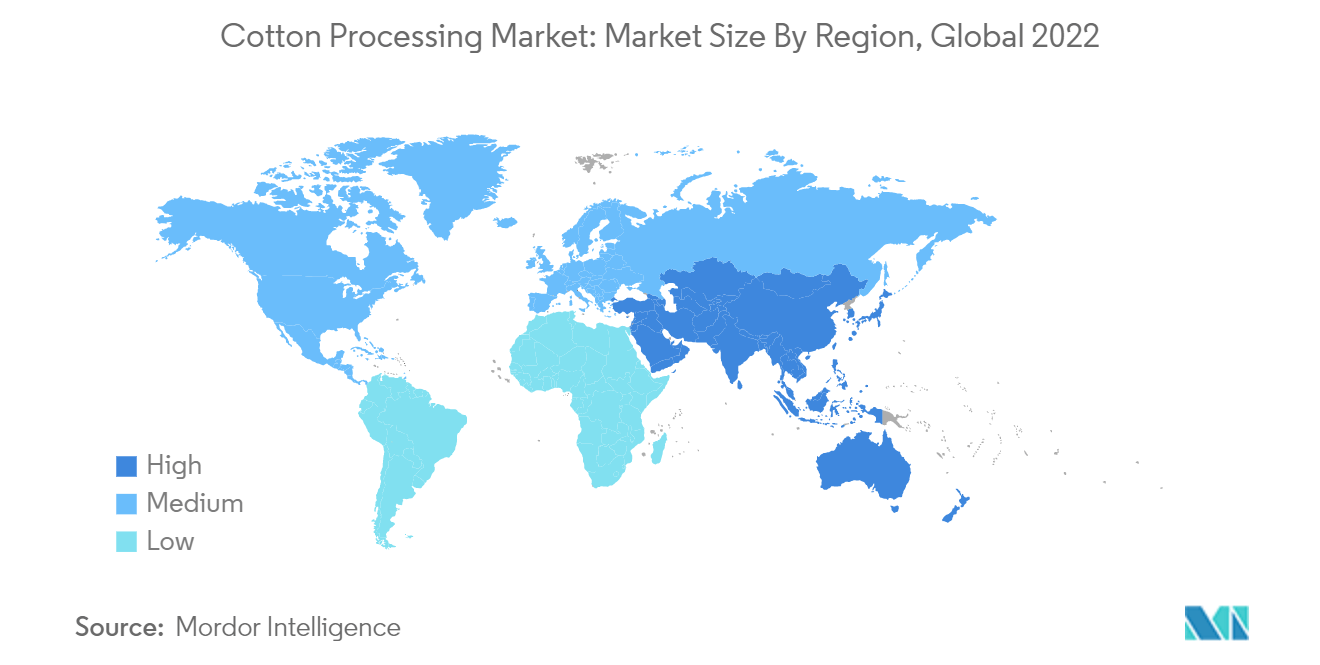
Cotton Processing Industry Overview
The global cotton processing market is consolidated, with a few significant players occupying a majority of the market share. The leading players in the market, like Lummus Corp. Cherokee Fabrication, Shandong Swan Cotton Industrial Machinery Stock Co., Nipha Exports, and Bajaj, focus on increasing their presence through undertaking investments and expansions and developing products specific to consumer preferences in these regions. Most of the major companies have a strong presence in the Asia Pacific and North American regions.
Cotton Processing Market Leaders
-
Lummus Corp.
-
NIPHA EXPORTS PRIVATE LIMITED
-
Bajaj Group of Companies
-
Shandong Swan Cotton Industrial Machinery Stock Co.
-
Cherokee Fabrication
*Disclaimer: Major Players sorted in no particular order
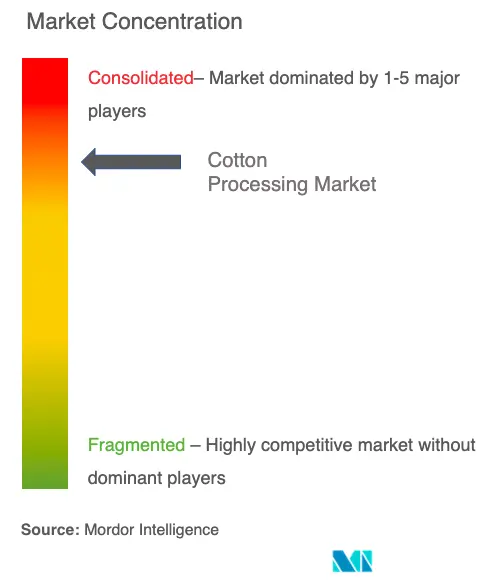
Cotton Processing Market News
- July 2022: Cotton production has increased in (August 2022-July 2023) by 3.3 percent, but consumption and world trade may remain stagnant or see a marginal rise according to the US Department of Agriculture (USDA) because of lower consumption by China, Bangladesh, and Vietnam which shows the effect on high container rates and limited supply, besides rising inflation and hike in interest rates globally.
- December 2021: Lummus Ag Technology has expanded its manufacturing center in Savannah, GA which continues to streamline operations and grow the capacity of the production and services and parts, it has made the decision to consolidate manufacturing operations into the Savannah, GA location.
- July 2020: Lummus Technology was acquired by Haits ldia Petrochemicals Limited and Rhône Capital. The acquisition objective is to develop strategies to deliver technology and services to a broader customer base.
Cotton Processing Market Report - Table of Contents
1. INTRODUCTION
- 1.1 Study Assumptions and Market Definition
- 1.2 Scope of the Study
2. RESEARCH METHODOLOGY
3. EXECUTIVE SUMMARY
4. MARKET DYNAMICS
- 4.1 Market Overview
- 4.2 Market Drivers
- 4.3 Market Restraints
-
4.4 Porter's Five Forces Analysis
- 4.4.1 Bargaining Powers of Buyers
- 4.4.2 Bargaining Powers of Suppliers
- 4.4.3 Threat of New Entrants
- 4.4.4 Threat from Substitute Products and Services
- 4.4.5 Intensity of Competitive Rivalry
5. MARKET SEGMENTATION
-
5.1 Cotton Product Type
- 5.1.1 Lint
- 5.1.2 Cottonseed
- 5.1.3 Other Product Types
-
5.2 Application
- 5.2.1 Textiles
- 5.2.2 Surgical and Medical
- 5.2.3 Feed
- 5.2.4 Other Applications
-
5.3 Equipment
- 5.3.1 Spinning
- 5.3.2 Ginning
- 5.3.3 Other Equipment
-
5.4 Operation
- 5.4.1 Automatic
- 5.4.2 Semi-Automatic
- 5.4.3 Other Operations
-
5.5 Geography
- 5.5.1 North America
- 5.5.1.1 United States
- 5.5.1.2 Canada
- 5.5.1.3 Mexico
- 5.5.1.4 Rest of North America
- 5.5.2 Europe
- 5.5.2.1 United Kingdom
- 5.5.2.2 France
- 5.5.2.3 Italy
- 5.5.2.4 Spain
- 5.5.2.5 Germany
- 5.5.2.6 Rest of Europe
- 5.5.3 Asia Pacific
- 5.5.3.1 China
- 5.5.3.2 India
- 5.5.3.3 Japan
- 5.5.3.4 Australia
- 5.5.3.5 Rest of Asia Pacific
- 5.5.4 South America
- 5.5.4.1 Brazil
- 5.5.4.2 Argentina
- 5.5.4.3 Rest of South America
- 5.5.5 Africa
- 5.5.5.1 South Africa
- 5.5.5.2 Rest of Africa
6. COMPETITIVE LANDSCAPE
- 6.1 Most Adopted Strategies
- 6.2 Market Share Analysis
-
6.3 Company Profiles
- 6.3.1 Bajaj Group of Companies
- 6.3.2 Balkan Group of Companies
- 6.3.3 Bhagwati Engineering Works
- 6.3.4 CAMOZZI GROUP SpA
- 6.3.5 Cherokee Fabrication
- 6.3.6 Karunanand Hydropneumatic Controls (P)
- 6.3.7 Lummus Corp.
- 6.3.8 Mitsun Engineering
- 6.3.9 NIPHA EXPORTS PRIVATE LIMITED
- 6.3.10 Rieter
- 6.3.11 SAMUEL JACKSON INC.
- 6.3.12 Shandong Swan Cotton Industrial Machinery Stock Co.
- 6.3.13 Toyota Industries Corporation
- *List Not Exhaustive
7. MARKET OPPORTUNITIES AND FUTURE TRENDS
** Subject To AvailablityCotton Processing Industry Segmentation
The cotton processing market includes machinery used to convert raw cotton into forms utilized by several industries, like medical and textile. The Cotton Processing Market is Segmented by Product Type (Lint, Cottonseed, and Other Product Types), Application (Textiles, Surgical and Medical, Feed, and Other Applications), Equipment (Spinning, Ginning, and Other Equipment), Operation (Automatic, Semi-automatic, and Other Operations), and Geography (North America, Europe, Asia Pacific, South America, and Africa). The report offers market sizing and forecasts in terms of value (USD million) for all the above segments.
| Cotton Product Type | Lint | |
| Cottonseed | ||
| Other Product Types | ||
| Application | Textiles | |
| Surgical and Medical | ||
| Feed | ||
| Other Applications | ||
| Equipment | Spinning | |
| Ginning | ||
| Other Equipment | ||
| Operation | Automatic | |
| Semi-Automatic | ||
| Other Operations | ||
| Geography | North America | United States |
| Canada | ||
| Mexico | ||
| Rest of North America | ||
| Geography | Europe | United Kingdom |
| France | ||
| Italy | ||
| Spain | ||
| Germany | ||
| Rest of Europe | ||
| Geography | Asia Pacific | China |
| India | ||
| Japan | ||
| Australia | ||
| Rest of Asia Pacific | ||
| Geography | South America | Brazil |
| Argentina | ||
| Rest of South America | ||
| Geography | Africa | South Africa |
| Rest of Africa |
Cotton Processing Market Research FAQs
What is the current Cotton Processing Market size?
The Cotton Processing Market is projected to register a CAGR of 4.10% during the forecast period (2024-2029)
Who are the key players in Cotton Processing Market?
Lummus Corp., NIPHA EXPORTS PRIVATE LIMITED, Bajaj Group of Companies, Shandong Swan Cotton Industrial Machinery Stock Co. and Cherokee Fabrication are the major companies operating in the Cotton Processing Market.
Which is the fastest growing region in Cotton Processing Market?
Asia Pacific is estimated to grow at the highest CAGR over the forecast period (2024-2029).
Which region has the biggest share in Cotton Processing Market?
In 2024, the Asia Pacific accounts for the largest market share in Cotton Processing Market.
What years does this Cotton Processing Market cover?
The report covers the Cotton Processing Market historical market size for years: 2019, 2020, 2021, 2022 and 2023. The report also forecasts the Cotton Processing Market size for years: 2024, 2025, 2026, 2027, 2028 and 2029.
Cotton Processing Industry Report
Statistics for the 2024 Cotton Processing market share, size and revenue growth rate, created by Mordor Intelligence™ Industry Reports. Cotton Processing analysis includes a market forecast outlook to 2029 and historical overview. Get a sample of this industry analysis as a free report PDF download.



